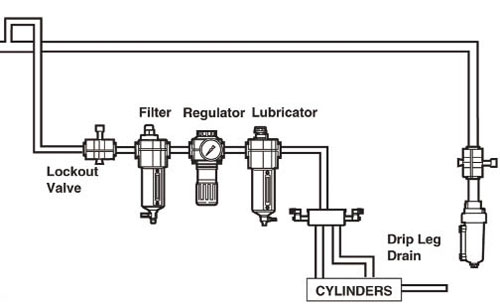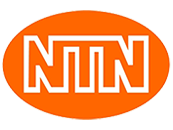A filter regulator is a combination of a filter and pressure regulator in a single unit. Both of these are also available as separate units. The benefit is that the single unit takes less space, reduces the chance of leaks due to less air connections and, in some cases, can improve the performance.
How does a filter regulator work?
Here, we must consider the basic working principles of the individual elements of the filter and regulator:
- Filter: The filter body has a construction that creates a cyclonic action for the incoming air. This action works to deposit water and heavier particles to the bottom of the bowl. A baffle, under the filter element, prevents the deposited water and debris being sucked back into the output air flow. Air is then forced through a filter element, the mesh size determining the minimum size of particle removed from the air flow. So, for example, a 40 micron filter will remove all particles greater than 40 micron in size. 5 micron elements are also available, as are oil and vapour removal filters.
- Regulator: The control knob works against a spring which, in turn, places load against a diaphragm assembly. The diaphragm pushes down on a valve pin connected to the valve seat and the seat drops; this allows downstream air flow from the inlet port (P1) out of the outlet port (P2). As air passes down P2, a breathe hole lets air into a chamber below the diaphragm; once pressure either side of the seat is equal, the seat closes with the aid of the spring. Downstream demand will cause a pressure drop in the chamber, opening the seat and allowing air to flow again until pressure is once more equalised and the seat closes. The process is continuous, maintaining P2 at a set value.
How do I select a filter regulator?
There are a number of considerations in choosing a filter regulator unit.
- What is the flow rate required for a process or system? This will determine the port size.
- What level of filtration is required and to what level of dryness? The general purpose filter is 40 micron, but 5 micron is also available. As a rule, air would be filtered to 40 micron first, before applying the 5 micron filtration. A 40 micron filter will typically remove 95% of the water content; putting the filters in series means 95% of the remaining 5% will be removed, giving water removal approaching 99%. After 5 micron removal, oil, then vapour removal filters can be applied.
- What is the pressure requirement to operate downstream equipment and what is the supply pressure? This will be the task of the pressure regulator. It is important to note that a quantifiable pressure drop will occur through the filter regulator unit.
Types of filter regulators
The standard Excelon Plus models have ports from G3/8 to G3/4, auto or manual drain and guarded polycarbonate or metal with level indicator bowls. 40 micron filter elements are fitted for all standard options, as is an integrated gauge. Other options are available, for example 5 micron filter elements.
The Olympian Plus standard range has ports G1/4 to G3/4 and auto or manual drain. A metal bowl and 40 micron filter element is fitted to all standard options.
Typical applications of filter regulators
Simply put, you are likely to find a filter regulator unit in any compressed air system. They can be found in the main supply line and in branch lines supplying specific components that may require, for example, different pressure supply or higher grade filtration
Do I need anything else to make a filter regulator work?
Depending on application, the filter regulator unit may be part of a system with other components, for example, a lubricator and shut-off valve. Where required (Excelon Plus has an integral gauge), a gauge is separately available. Mounting brackets will be required, as will tubing and fittings and a tamper resistant kit is available, with padlock as an option for additional security.










